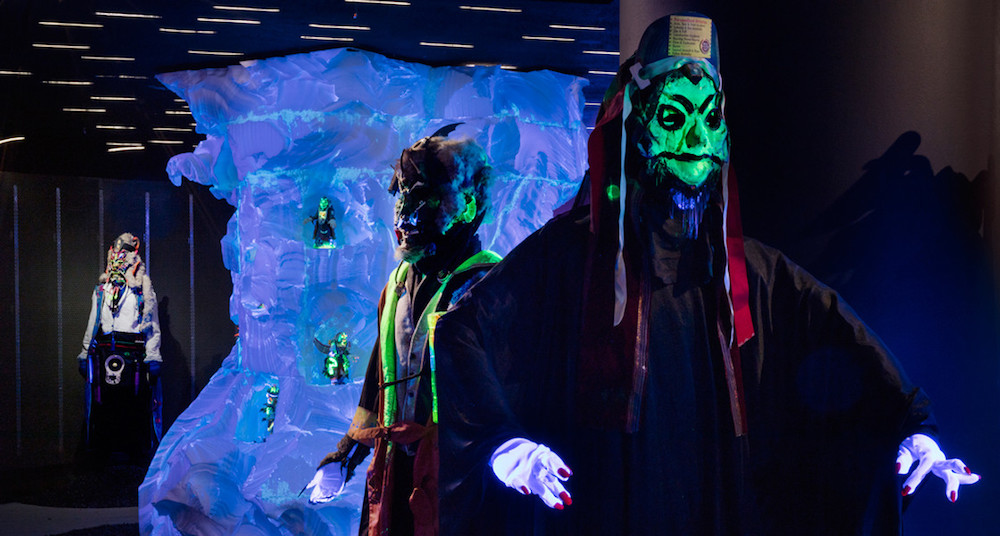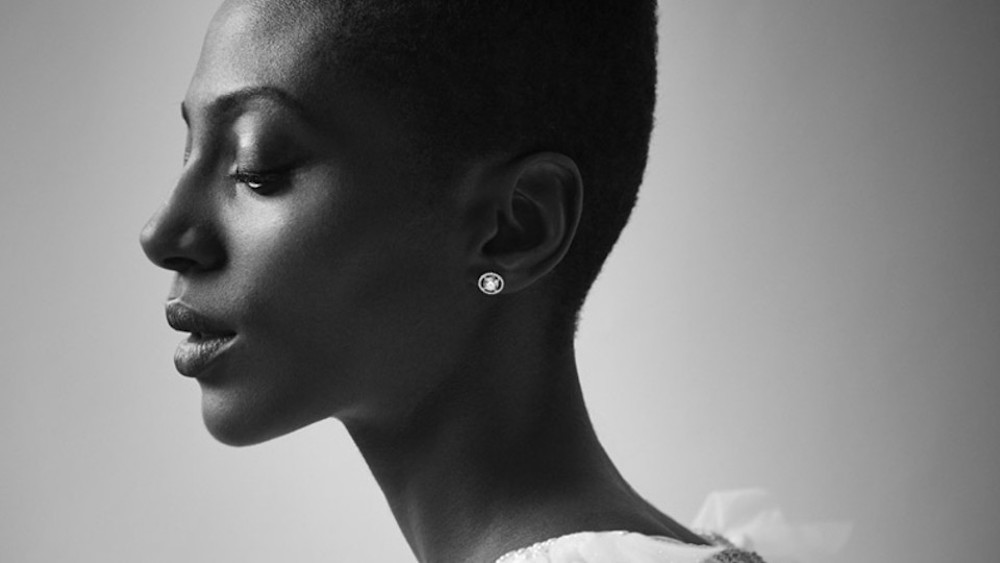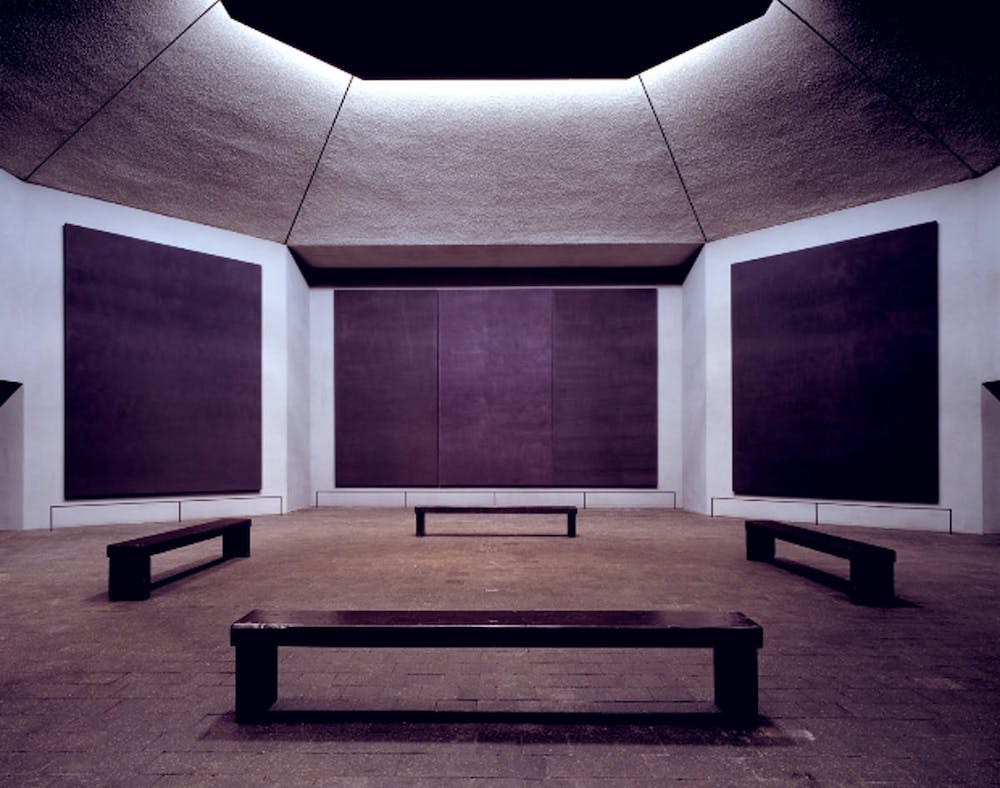I first learned about the artist Rammellzee from Dave Tompkins’s book, How to Wreck a Nice Beach, and I saw his Letter Racer sculptures in an exhibition a few years ago (which Tompkins wrote about for the Daily). Rammellzee is easily one of the most unique and most overlooked artists of the past fifty years, but until seeing the survey “Racing for Thunder” this week at Red Bull Arts, I hadn’t realized the extent of his genius. It’s impossible to sum up the breadth and depth of his Ikonoklast Panzerism (in which language is armored for protection) and the prophetic Gothic Futurist project in a few sentences—overlapping modes of music, graffiti, collage, performance, sculpture, writing. He worked according to faith and intellect and intense creativity. Included in this show are his Garbage Gods, intricate costumes constructed from material found on the streets of New York. (His loft-studio, the Battle Station, was on Laight Street in Tribeca.) Each figure is composed of and encrusted with myriad small objects—belt buckles, calculators, radio antennae, jewelry, lots of random plastic stuff—but the individual items disappear into the form of the structure; the whole is the sum of its parts. In these costumes, the fluidity of Rammellzee’s vision is most apparent: in a bit of discarded nothingness, he saw not just a larger creation but a world, a system, and a future. —Nicole Rudick
It is difficult to pinpoint exactly what Sayaka Murata is doing in her award-winning novel Convenience Store Woman, which will be published in English next month. The plot (which really reads more like a long short story or a novella) follows a convenience-store employee nearing middle age, a woman who since childhood has been unable to perceive or adhere to social cues or norms. In her job as a clerk, however, she happily and successfully follows the unspoken guidelines and regulations of social transaction. The novel feels, at turns, like a critique of consumer culture and the strange comfort it provides, a feminist critique of the societal expectations placed on single women as they age, and an odd experiment with personality, forcing us to ask ourselves how much we draw on the outside world to shape what we believe to be our own unique identity. Amid these shifting perspectives, what remains constant is the witty, dark humor and charm of the well-intentioned narrator, who wants nothing more than the autonomy to simply do her job. —Lauren Kane
On a slow day at work last week, I tore through Yrsa Daley-Ward’s poetic memoir, The Terrible, in a matter of hours. I opened the book, read the words “My little brother and I saw a unicorn in the garden in the late nineties. I’m telling you,” and then four hours had passed, the sun had descended, and I had lived through a childhood in Northern England, a precarious adolescence, and a dangerous young adulthood. This is a complicated story, comprising dozens of characters and taking place over decades, and I wasn’t familiar with any of it, except to the extent that being black in America translates to being black in England. Somehow, though, I was able to glean the complexities of Daley-Ward’s life as lucidly as if it were my own. Untethered, the memoir slips in and out of tenses, perspectives, and styles, as the narrator sees fit. The Terrible is an impressive take on the memoir that prioritizes emotion over event, and Penguin Books is publishing it in less than a month. —Eleanor Pritchett
My girlfriend is writing about The Fourth Estate—a new documentary series about the New York Times’s coverage of the Trump administration—and so in a plus-one capacity, I recently got to watch the first three episodes. (It premieres on Showtime on May 27.) If you compulsively check the Times’s website, and did so throughout 2017, it’s fascinating to see, Rashomon-style, what was happening on their side of the screen: the staff meetings, the moments where they huddle around a single computer monitor, the dopamine fireworks whenever the Washington bureau chief, Elisabeth Bumiller, clicks the “publish” button. In one scene, Maggie Haberman takes a call from Trump, and you hear his voice from her earpiece. You hear how she laughs at his lame jokes and lets him feel that he is charming, and gets him to talk. (He goes off the record at one point. Those lines are tantalizingly bleeped.) When, in a different mode, Trump attacks the media to their faces at a rally in Phoenix, and his followers hurl threats, the camera is right there on the profoundly outnumbered Times reporter Mark Landler. You also glimpse these journalists’ personal lives, or lack thereof: Matthew Rosenberg makes a quick breakfast for his kids and spills his raspberries on the kitchen floor; Michael S. Schmidt talks about how he doesn’t even keep food in his apartment—he’s a bachelor, and all he does is work. Like any docuseries with reoccurring characters, the staff starts to feel like “the gang,” like a reality-show cast, and this is part of what makes The Fourth Estate fun and not just a stressful reliving of Trump’s America in 2017, set to the music of Trent Reznor. In the words of Haberman, who answers her cell phone right after posting the story about Priebus’s firing, “Are you just calling to say, Holy shit, can you believe this isn’t just an episode of House of Cards?” —Brent Katz
The late-afternoon light is thick on the ground in Houston. The long shadows of oak-tree branches feel unconnected to the light, more like paintings on the grass. Amid this gold-and-green landscape sits the Rothko Chapel, a squat octagonal building. Inside is one room of eight white walls hung with fourteen monumental monochrome Mark Rothko canvases, each seeming at first a solid pane of black. The only light is that which filters through a skylight fitted with a dark parasol. The outside light is abundant, but here, light is parceled out reluctantly, like a precious and guarded commodity. The Rothko Chapel is a space demanding time, for as your eyes adjust and you become attuned to the slightest shift in the light outside, the featureless black dissolves to reveal other colors glowing beneath—a purple spackle, a blue streak, a flash of red, a yellow haze between purple. It is like being inside a great closed eye. One does not see the paintings so much as one engages with the phenomenon of seeing. It reminded me of a tour I once took in a submarine. Before we left, the guide gave us a palette of color swatches and instructed us to watch them while we descended. As we did, and the light filtering down grew weaker, the colors drained and began to converge into a single grayish shade. Yet I could still see, or think I saw, a small suggestion of blue in the blue, red in the red, and I found them more beautiful in their spaciousness, blocks of color far from any light, shining. —Matt Levin
The camera is too close. Standing on a porch somewhere—it could be anywhere—the man sucks a long drag off a cigarette, dips the lens so we can see the smoke, and spits. “It’s fuckin’ nice out,” he says, and though you can’t see what he sees, you believe him. This is Young King Dave, a neck-bearded proponent of weed, a wannabe rapper, and the creator of some of the funniest things I saw on the Internet last year. With the oddball charisma of so many dead-end characters I met in high school, he coined his own vernacular (the comically large blunts he smokes are “doinks”; a stand of corn on the side of a rural highway is “in Amish”) and stole my heart. And like these same dead-end characters getting picked off one by one back in my hometown—by suicide, opioids, car crashes, other circumstances—Young King Dave is dead. He was nineteen. And though I saw him only in these twenty-second slices, blasted out across social media, I feel like I knew him. How do I mourn this loss? How often do we consider the human on the other side of a meme? Where is Lil Meatball? The screaming chasm of the Internet offers few pleasures. Young King Dave was one of them. Rest in peace. —Brian Ransom
from The Paris Review https://ift.tt/2rTSaMu




Comments
Post a Comment